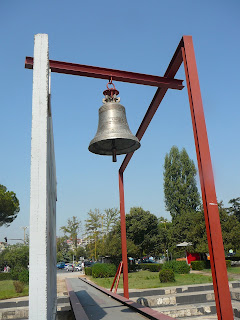When many of my friends found out I was traveling to Albania their first response was often "What's in Albania?" or "Why Albania?". Well I wanted to visit Albania because it is such an unknown to many people due to its decades of isolation under Enver Hoxha. My interest in post-communist states and Eastern European history also drew me to Tirana. Tirana is a city that reminds me of Yerevan in many ways, but also has the evidence of a stronger European influence than in Armenia. Albania is a country that was ruled over by many empires and ideologies all of which are evident in its architecture, cuisine, and people, which makes it a fascinating place worth visiting to me.
The cheapest way for us to travel from Athens to Tirana was to take the 11 hour overnight bus, which became a 16 hour journey because it took 5 hours to cross the border. Many tour companies run overnight buses to Tirana and that means that they all arrive at the Greek-Albanian border at the same time and each bus has to wait its turn to cross the border. We spent our first night in Tirana relaxing at our hostel and recovering from our bus ride. The next day we explored the streets of Tirana and this is what we saw.
The Pyramid was built in 1988 (can't you tell!) by Enver Hoxha's daughter and son-in-law to serve as the Enver Hoxha Museum. It is now home to cultural events and teenage graffiti artists. Hoxha founded the Albanian communist party in 1941 to fight back against the fascist occupation of Albania by the Italians. He was in power until his death in 1985. He kept the country extremely isolated breaking off relations with Yugoslavia in 1948. He maintained relations with the Soviet Union during Stalin's years, but after Khrushchev came to power and criticized the cult of personality surrounding Stalin, Hoxha broke with Soviet-style communism in 1960. After this Albania aligned with China and from 1966 to 1967 Albania underwent its own cultural revolution. Atheism was promoted and churches and mosques were destroyed and the collectivization of agriculture was completed. Hoxha built tens of thousands of igloo-shaped concrete bunkers that still dot the hills of the country. With Mao's death in 1976 Albania's unique relationship with China came to an end and the country became isolated with no allies.
The Bell of Peace was forged from bullet casings from the 1997 conflict in Albania.
Parliament Building: After Hoxha's death restrictions loosened a bit, but the whole system of government was falling apart. Throughout the 1990s thousands of Albanian fled to Western embassies in Tirana and to Italy in search of political asylum. The government finally agreed to allow opposition parties and the 1992 elections ended 47 years of communist rule in Albania. The transition from communism to free market led to increased corruption and smuggling. A severe economic crisis led to 70% of Albanian's losing their savings and rioting and looting in the streets. The situation has stabilized during the first decade of the 21st century, but it is estimated that around 25% of the population lives in poverty.
Communist-style Apartment Buildings fill the neighborhoods of Tirana. These buildings are a feature of all cities and towns throughout Eastern Europe, but unlike those of Armenia the one's in Tirana have been painted with bright colors and patterns. This really adds a sense of hope to the city and takes away from the grim nature of concrete block towers.
Italian Architecture: Albanian King Zog I cooperated extensively with the Italians in developing Albania during the 1930s. The Italians built grand boulevards and beautiful buildings from the Fascist school of architecture (that's right there is a Fascist style) and helped turn Tirana into a true capital city. However, this left Albania indebted to Italy and basically a de facto colony. In 1939 Mussolini ordered the invasion of Albania and King Zog fled to England. The Italians occupied Albania throughout World War II.
Skanderbeg: This statue of Albanian national hero Skanderbeg looks out over Skanderbeg Square, which is currently a giant construction site because the square is being renovated to be a pedestrian only area. Skanderbeg is a national hero because from 1443 to 1468 he led the Albanian resistance against takeover by the Ottoman Empire. He won all 25 battles he fought against the Turks and although the Ottoman's finally overwhelmed the Albanian resistance - it was only after 26 years of fighting.
Et'hem Bey Mosque was built in the 18th century and managed to survive destruction during Hoxha's 1960s atheism campaigns due to its beauty and its status as a cultural monument.
Mother Teresa Square: While Mother Teresa may be one of the most famous Albanians sadly the square meant to honor her is not much more than this statue and an empty concrete fountain.
Mother Albania sits atop a hill overlooking Tirana surrounded by Martyrs' Cemetery where 900 Albanian partisans who died in World War II are buried.
We took a day trip to Kruja, the site of Skanbderbeg's castle, during our time in Albania. Located about 45 minutes north of Tirana the ancient site is now surrounded by the modern city of Kruja. Skanderbeg was born in Kruja and Albanians still take pride in that fact that he and his forces defended Kruja until his death.
Next Stop: Ohrid, Macedonia












This was a really nice post. Thank you for visiting Albania!
ReplyDelete